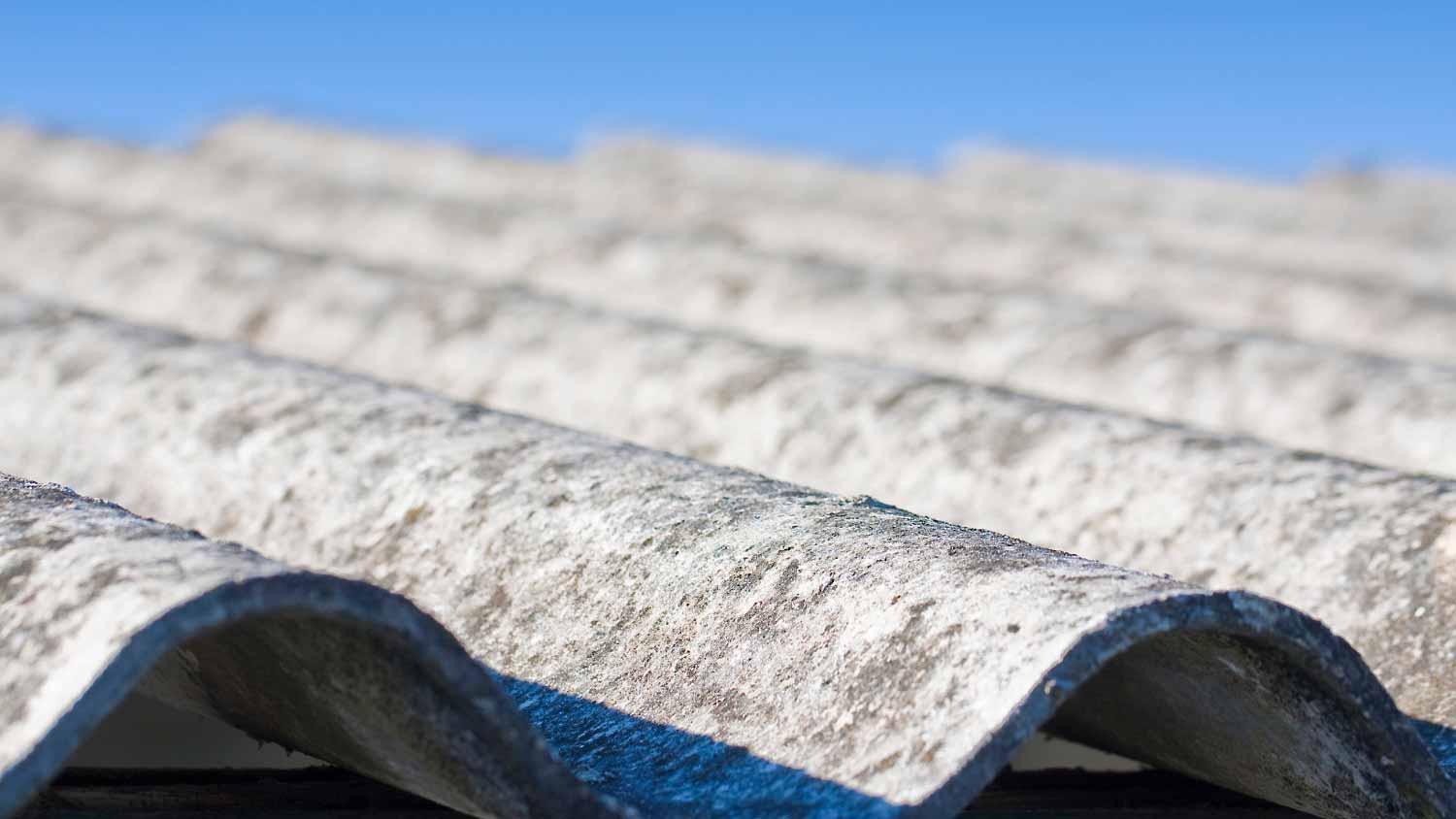
The cost of asbestos testing varies based on location, property size, test type, and other factors. Here’s a breakdown of the costs to conduct an asbestos survey.
This potentially dangerous mineral fiber can be a cause for concern in older homes


Homes built before the 1980s may have asbestos-containing materials.
When disturbed, the materials could release asbestos fibers into the air.
Asbestos fibers are a known carcinogen when humans inhale them.
The microscopic fibers can remain airborne for days and have no odor.
Hiring an asbestos abatement professional is the best way to remove asbestos.
Older homes come with plenty of charm. But if your home was built before the 1980s, asbestos could be lurking in the walls, ceilings, tiles, and other areas. But what is asbestos, exactly? This fibrous mineral was used prolifically in insulation and other commercial products before the 1980s. Learn more about asbestos, how to identify it, and what you can do about it.
Asbestos is a fibrous mineral that is found in rock and soil. This mineral is known for its strength and resistance to heat—qualities that led to it being widely used in commercial products and building materials for insulation and as a fire retardant. As they age, products made with asbestos can release microscopic fibers. Undetected, these fibers can linger in the air for days after the initial disturbance, ready to enter human lungs when inhaled. The fibers can go deep within a person’s lung cavity, lodging in the lung tissue. Over time, these fibers can cause lung cancer, lung tissue scarring (asbestosis), and cancer of the lung cavity lining (mesothelioma).
Although asbestos is no longer mined in the U.S., it is not completely banned. In fact, the material still lingers in some products and materials often found in structures built before 1980, according to the United States Environmental Protection Agency. In 1989, the Environmental Protection Agency (EPA) pushed for a partial ban on manufacturing, importing, processing, and distributing some asbestos-containing products. New asbestos products were also prohibited from entering the marketplace.

When was asbestos used in homes? If your home was built before 1980, there’s a good chance that it could have lingering asbestos. It’s helpful—and smart—to be aware of the spaces throughout your home that may have asbestos. Where is asbestos found? Here are some common areas where asbestos may have been used:
Roof materials (i.e., shingles)
Siding
Laminate flooring
Furnace and boiler
Insulation for old electrical wiring
Fireplaces
Pipe insulation
Wallboard
Wallpaper
Insulation used in walls and ceilings

Older homes are more likely to contain materials with asbestos, and data from Angi customers shows that 78.1% of homes that needed asbestos removal were built before 1978. Only 12.4% of homes needing asbestos removal were built after 1978. If you have an older home, preventative asbestos testing by a professional abatement company is a smart, safe choice.
The good news is that asbestos doesn’t become airborne just by having it in your home. Someone or something must disturb the material that contains the asbestos to make the fibers airborne and dangerous.
Some of the actions that can cause asbestos fibers to enter the air include:
Remodeling
Construction
Home repairs
Physical impacts
Water damage
Severe vibration
Scraping
Covering
Puncturing
Painting over it
When disturbed, asbestos doesn’t make dust like you might expect. Instead, it breaks into microscopic fibers that can hang in the air for a few days. You cannot see, feel, or smell these fibers, and you won’t know if you inhale them.
The three most common types of asbestos that appear in residential and commercial properties come in distinct colors. Homeowners should also periodically check for water damage, as well as tears and abrasions on the material. But, according to the EPA, there’s only one way to confirm that a material has asbestos: have it tested by a qualified laboratory.
When tackling this issue, it’s important to answer: “What does asbestos look like?” Knowing what asbestos looks like can help keep you alert and safe. Three types of asbestos are usually found in commercial and residential buildings throughout the United States:
This asbestos, which is brown, was widely used in insulation boards and ceiling tiles. Amosite, which was the second most-used asbestos, poses the greatest risk of cancer out of all of the types.
This white asbestos is the most commonly used type, appearing in everything from roofs and ceilings to walls and floors.
Blue in color, this is the most hazardous type of asbestos. It was used in spray-on coatings, plastics, and pipe insulation.
You can test for asbestos on your own by buying an asbestos testing kit at a local hardware store or online. However, it can be dangerous to run a test yourself because you must disturb the materials to scrape off a sample piece.
By the time you buy all the protective gear you need along with the kit, you may find it more cost-effecitve to simply hire a professional to do the testing for you. Who do you call to check for asbestos? A local asbestos testing company can do this work for you.
If you have asbestos, a local asbestos abatement pro will conduct an asbestos inspection (also called an asbestos survey). A survey, which confirms the presence of asbestos, includes several elements, such as air testing, duct sample testing, and physical sample testing. Typically, asbestos testing costs will range from $230 to $782. The final cost for an asbestos survey will depend on other factors, ranging from your property’s size and condition to your geographic location. If the survey results come back positive for asbestos, it’s best to arrange for it to be managed or removed.
If an asbestos survey confirms that there’s asbestos in your home, you should remove it for safety and other reasons. Does asbestos affect home value? Having asbestos can affect the value of a home because you must disclose the presence of asbestos to any potential home buyers, who may then reduce the amount they offer.
It’s often easier to remove it through abatement than to have to disclose its presence. Asbestos abatement is the process of managing and removing the asbestos material from a home or building.
The EPA recommends dealing with asbestos in one of three ways:
If the material is in good condition, it most likely will not pose a health risk. However, it’s still a best practice to keep children away from the material.
This process would include leaving the material in place and binding it through enclosure or encapsulation, which would prevent the asbestos fibers from being airborne. For example, floor tile with asbestos could be enclosed by covering it with new flooring.
If the material is damaged or could be disturbed by a home renovation project, consider removing it. This process can be complex and time-consuming. Asbestos removal costs range from $450 to $6,000, depending on the selected removal process, the amount of asbestos, and the space size.
To eliminate the asbestos problem, you have the option of covering it with paint or concrete. You can’t just buy any gallon of paint at the local hardware store to cover it, though. You must use a product that works as an encapsulating material. The right material keeps the asbestos fibers from becoming airborne in the future.
While performing the encapsulation process, you could disturb the material and create airborne asbestos fibers. If you want to do this work yourself, you must wear protective equipment and take precautions. For peace of mind, you can hire an abatement professional who has experience with encapsulating asbestos materials.
Asbestos can be dangerous, so it’s best to hire a pro to remove it from your home. However, if you are considering taking a DIY approach to handling asbestos, follow these precautions:
Seal off the work area with plastic sheets.
Turn off the air conditioning and furnace to avoid spreading asbestos fibers.
Wear proper gear, including disposable coveralls, gloves, and a respirator with a high-efficiency particulate air (HEPA) filter.
Keep asbestos materials wet by using a pump sprayer.
Meticulously clean your work area with disposable wet wipes and a vacuum cleaner, preferably with a HEPA filter.
From average costs to expert advice, get all the answers you need to get your job done.

The cost of asbestos testing varies based on location, property size, test type, and other factors. Here’s a breakdown of the costs to conduct an asbestos survey.

Get clear answers on asbestos tile removal cost, including average prices, cost factors, and tips to save money on safe, professional removal.

Asbestos removal costs vary based on where it’s located, the size of the job, and if there is any underlying damage. Learn what has the biggest effect on the cost.

If you suspect there is vermiculite insulation in your home, you likely want it gone. Learn how to remove vermiculite insulation safely and quickly.

If you suspect asbestos in your home, who do you call to check for asbestos? Local asbestos testing companies can come to your home and do the work safely.

If you think asbestos may be lurking in your home, keep reading to learn about the dangers of asbestos exposure before you take any action.